Learning and Development Report: Mentoring for Performance Enhancement
VerifiedAdded on 2020/05/28
|12
|3661
|118
Report
AI Summary
This report delves into the crucial role of mentoring in learning and development, examining its impact on both individual and organizational performance. It begins by outlining the characteristics of a mentee and then explores the relationship between mentoring and individual performance, including aspects like personal development, responsibility, confidence, and employee satisfaction. The report then shifts its focus to mentoring's influence on organizational performance, highlighting its role in enhancing company culture, fostering employee growth, aligning organizational goals, and improving team efficiency and retention. Different mentoring methods, such as traditional, facilitated, and peer mentoring, are discussed. The report concludes with organizational examples, including the UK Police force, Boeing, Spark, and Intel, to illustrate the practical application and benefits of mentoring programs across diverse settings. The report emphasizes the importance of mentoring in fostering employee development and organizational success.
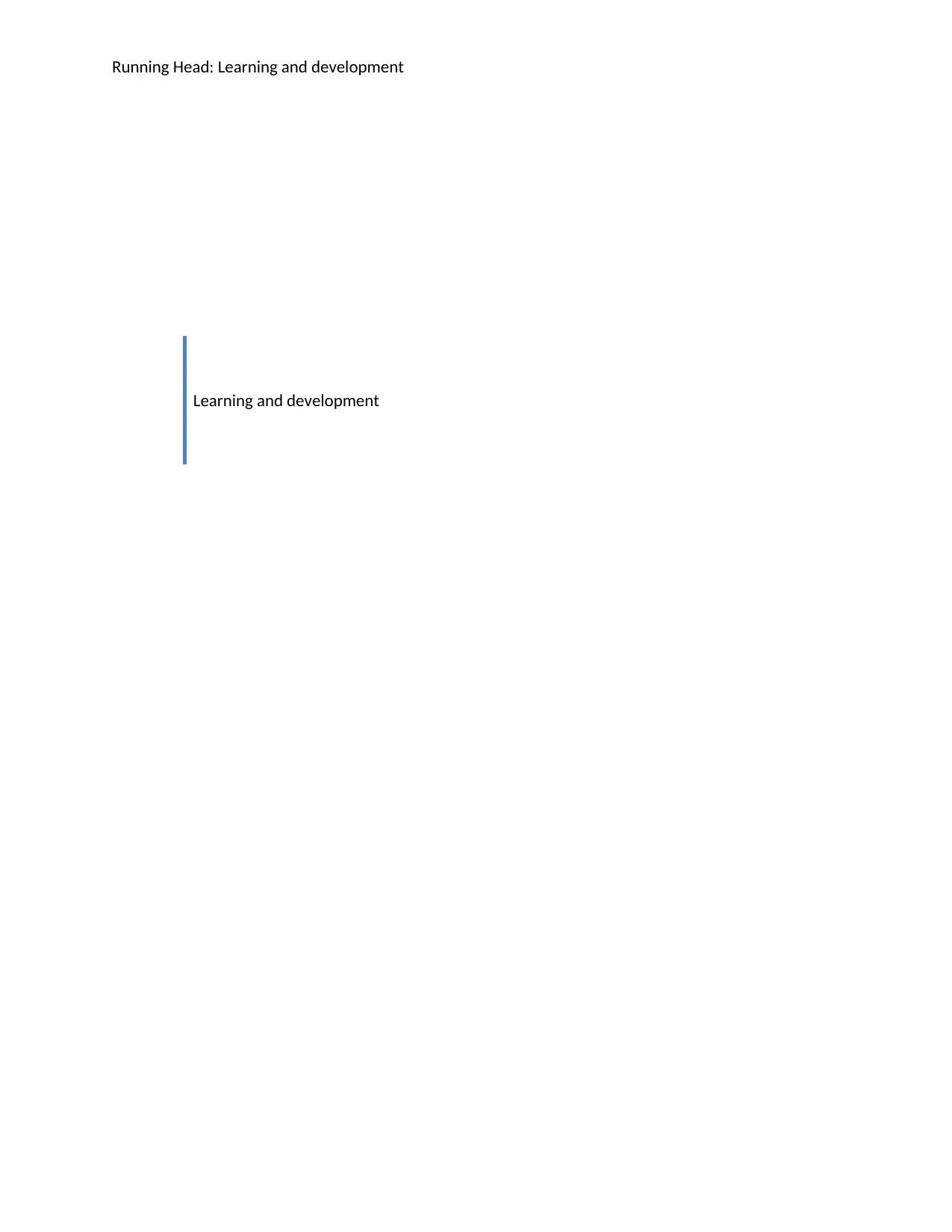
Running Head: Learning and development
Learning and development
Learning and development
Paraphrase This Document
Need a fresh take? Get an instant paraphrase of this document with our AI Paraphraser
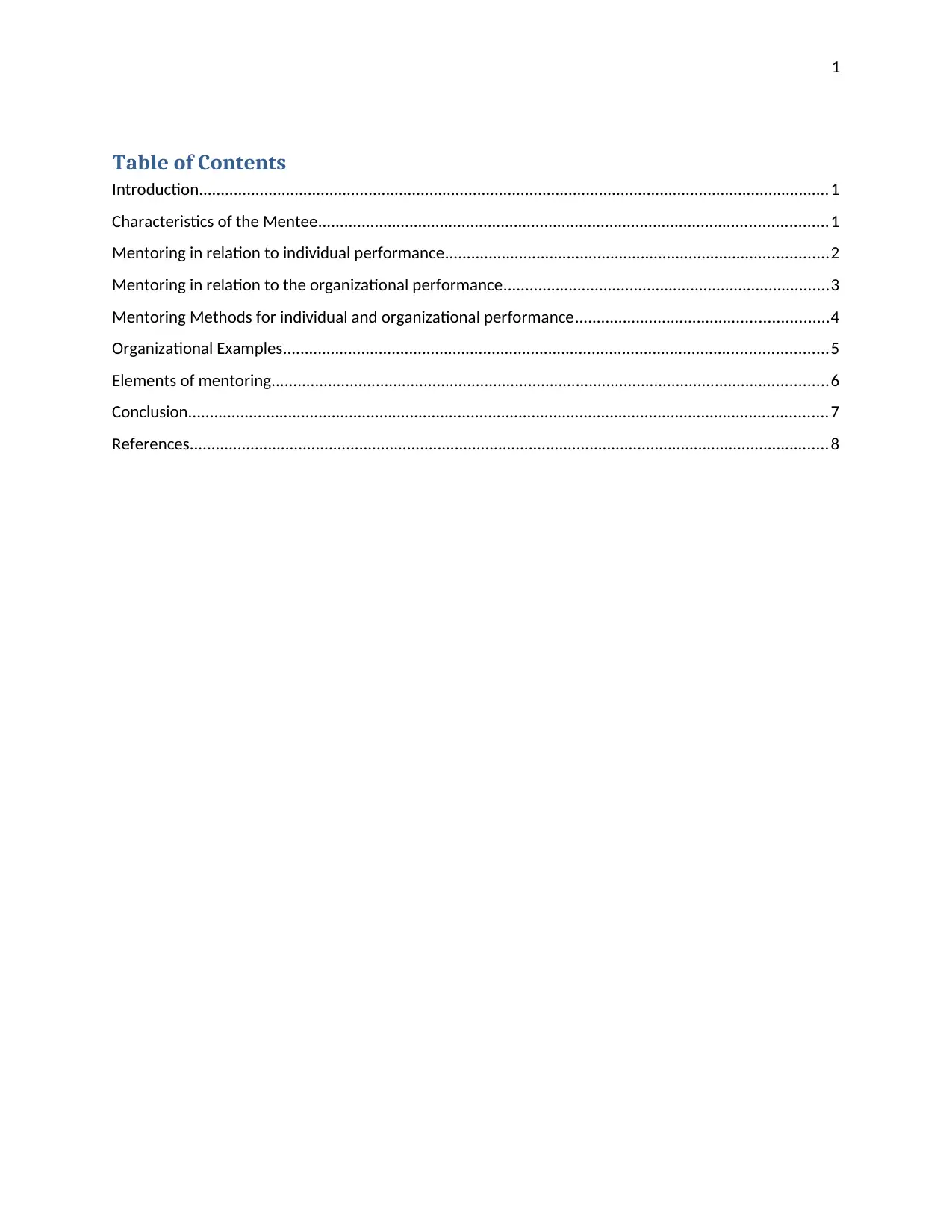
1
Table of Contents
Introduction.................................................................................................................................................1
Characteristics of the Mentee.....................................................................................................................1
Mentoring in relation to individual performance........................................................................................2
Mentoring in relation to the organizational performance...........................................................................3
Mentoring Methods for individual and organizational performance..........................................................4
Organizational Examples.............................................................................................................................5
Elements of mentoring................................................................................................................................6
Conclusion...................................................................................................................................................7
References...................................................................................................................................................8
Table of Contents
Introduction.................................................................................................................................................1
Characteristics of the Mentee.....................................................................................................................1
Mentoring in relation to individual performance........................................................................................2
Mentoring in relation to the organizational performance...........................................................................3
Mentoring Methods for individual and organizational performance..........................................................4
Organizational Examples.............................................................................................................................5
Elements of mentoring................................................................................................................................6
Conclusion...................................................................................................................................................7
References...................................................................................................................................................8
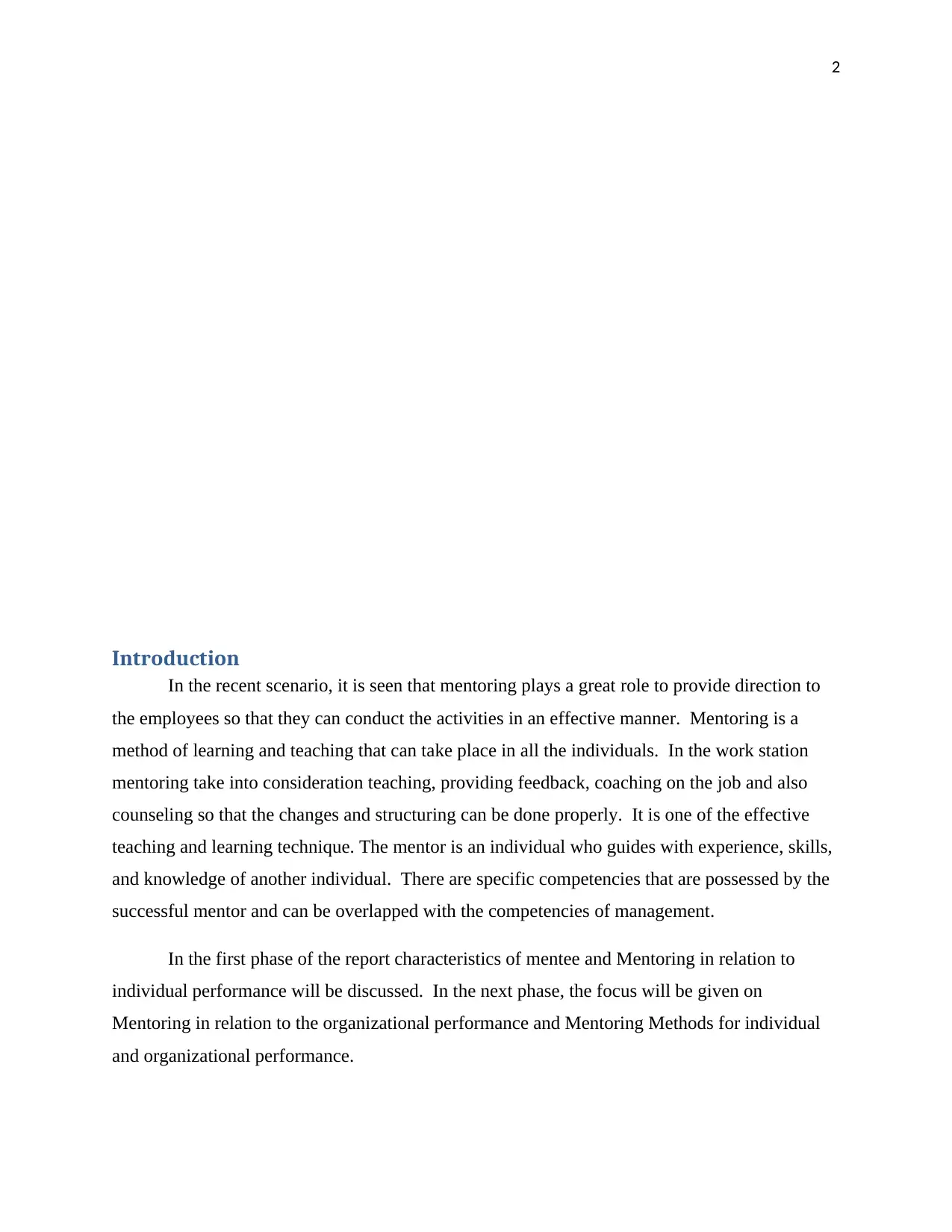
2
Introduction
In the recent scenario, it is seen that mentoring plays a great role to provide direction to
the employees so that they can conduct the activities in an effective manner. Mentoring is a
method of learning and teaching that can take place in all the individuals. In the work station
mentoring take into consideration teaching, providing feedback, coaching on the job and also
counseling so that the changes and structuring can be done properly. It is one of the effective
teaching and learning technique. The mentor is an individual who guides with experience, skills,
and knowledge of another individual. There are specific competencies that are possessed by the
successful mentor and can be overlapped with the competencies of management.
In the first phase of the report characteristics of mentee and Mentoring in relation to
individual performance will be discussed. In the next phase, the focus will be given on
Mentoring in relation to the organizational performance and Mentoring Methods for individual
and organizational performance.
Introduction
In the recent scenario, it is seen that mentoring plays a great role to provide direction to
the employees so that they can conduct the activities in an effective manner. Mentoring is a
method of learning and teaching that can take place in all the individuals. In the work station
mentoring take into consideration teaching, providing feedback, coaching on the job and also
counseling so that the changes and structuring can be done properly. It is one of the effective
teaching and learning technique. The mentor is an individual who guides with experience, skills,
and knowledge of another individual. There are specific competencies that are possessed by the
successful mentor and can be overlapped with the competencies of management.
In the first phase of the report characteristics of mentee and Mentoring in relation to
individual performance will be discussed. In the next phase, the focus will be given on
Mentoring in relation to the organizational performance and Mentoring Methods for individual
and organizational performance.
⊘ This is a preview!⊘
Do you want full access?
Subscribe today to unlock all pages.

Trusted by 1+ million students worldwide
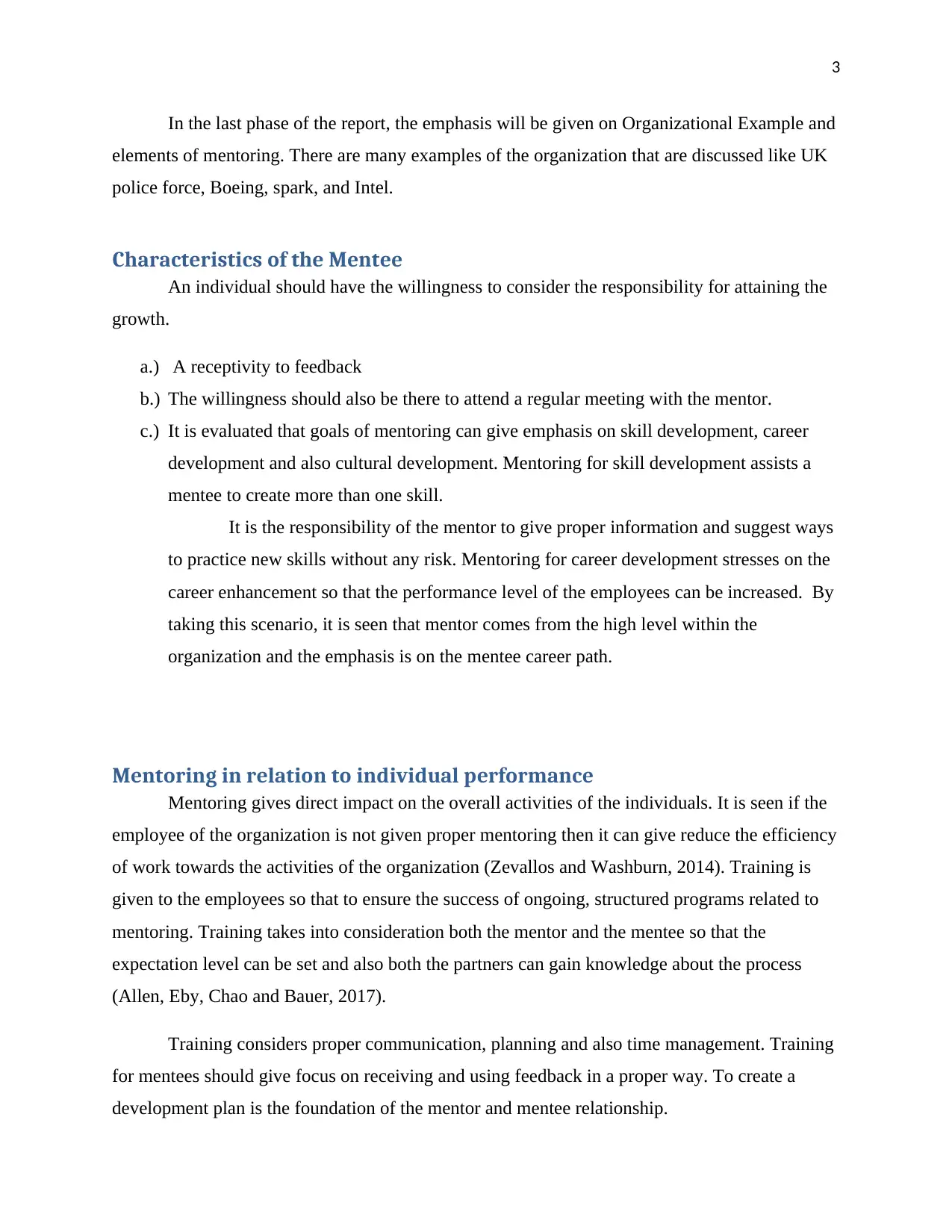
3
In the last phase of the report, the emphasis will be given on Organizational Example and
elements of mentoring. There are many examples of the organization that are discussed like UK
police force, Boeing, spark, and Intel.
Characteristics of the Mentee
An individual should have the willingness to consider the responsibility for attaining the
growth.
a.) A receptivity to feedback
b.) The willingness should also be there to attend a regular meeting with the mentor.
c.) It is evaluated that goals of mentoring can give emphasis on skill development, career
development and also cultural development. Mentoring for skill development assists a
mentee to create more than one skill.
It is the responsibility of the mentor to give proper information and suggest ways
to practice new skills without any risk. Mentoring for career development stresses on the
career enhancement so that the performance level of the employees can be increased. By
taking this scenario, it is seen that mentor comes from the high level within the
organization and the emphasis is on the mentee career path.
Mentoring in relation to individual performance
Mentoring gives direct impact on the overall activities of the individuals. It is seen if the
employee of the organization is not given proper mentoring then it can give reduce the efficiency
of work towards the activities of the organization (Zevallos and Washburn, 2014). Training is
given to the employees so that to ensure the success of ongoing, structured programs related to
mentoring. Training takes into consideration both the mentor and the mentee so that the
expectation level can be set and also both the partners can gain knowledge about the process
(Allen, Eby, Chao and Bauer, 2017).
Training considers proper communication, planning and also time management. Training
for mentees should give focus on receiving and using feedback in a proper way. To create a
development plan is the foundation of the mentor and mentee relationship.
In the last phase of the report, the emphasis will be given on Organizational Example and
elements of mentoring. There are many examples of the organization that are discussed like UK
police force, Boeing, spark, and Intel.
Characteristics of the Mentee
An individual should have the willingness to consider the responsibility for attaining the
growth.
a.) A receptivity to feedback
b.) The willingness should also be there to attend a regular meeting with the mentor.
c.) It is evaluated that goals of mentoring can give emphasis on skill development, career
development and also cultural development. Mentoring for skill development assists a
mentee to create more than one skill.
It is the responsibility of the mentor to give proper information and suggest ways
to practice new skills without any risk. Mentoring for career development stresses on the
career enhancement so that the performance level of the employees can be increased. By
taking this scenario, it is seen that mentor comes from the high level within the
organization and the emphasis is on the mentee career path.
Mentoring in relation to individual performance
Mentoring gives direct impact on the overall activities of the individuals. It is seen if the
employee of the organization is not given proper mentoring then it can give reduce the efficiency
of work towards the activities of the organization (Zevallos and Washburn, 2014). Training is
given to the employees so that to ensure the success of ongoing, structured programs related to
mentoring. Training takes into consideration both the mentor and the mentee so that the
expectation level can be set and also both the partners can gain knowledge about the process
(Allen, Eby, Chao and Bauer, 2017).
Training considers proper communication, planning and also time management. Training
for mentees should give focus on receiving and using feedback in a proper way. To create a
development plan is the foundation of the mentor and mentee relationship.
Paraphrase This Document
Need a fresh take? Get an instant paraphrase of this document with our AI Paraphraser
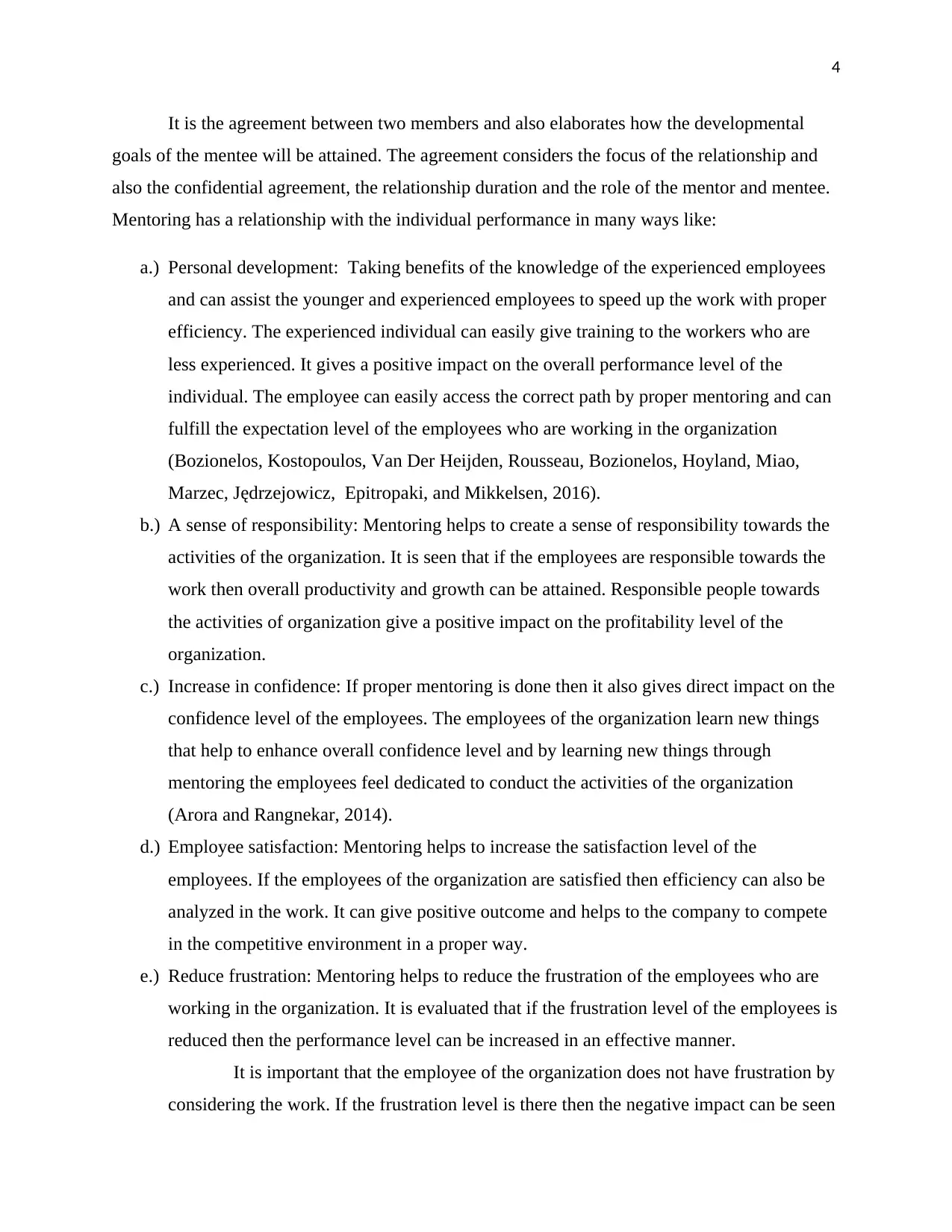
4
It is the agreement between two members and also elaborates how the developmental
goals of the mentee will be attained. The agreement considers the focus of the relationship and
also the confidential agreement, the relationship duration and the role of the mentor and mentee.
Mentoring has a relationship with the individual performance in many ways like:
a.) Personal development: Taking benefits of the knowledge of the experienced employees
and can assist the younger and experienced employees to speed up the work with proper
efficiency. The experienced individual can easily give training to the workers who are
less experienced. It gives a positive impact on the overall performance level of the
individual. The employee can easily access the correct path by proper mentoring and can
fulfill the expectation level of the employees who are working in the organization
(Bozionelos, Kostopoulos, Van Der Heijden, Rousseau, Bozionelos, Hoyland, Miao,
Marzec, Jędrzejowicz, Epitropaki, and Mikkelsen, 2016).
b.) A sense of responsibility: Mentoring helps to create a sense of responsibility towards the
activities of the organization. It is seen that if the employees are responsible towards the
work then overall productivity and growth can be attained. Responsible people towards
the activities of organization give a positive impact on the profitability level of the
organization.
c.) Increase in confidence: If proper mentoring is done then it also gives direct impact on the
confidence level of the employees. The employees of the organization learn new things
that help to enhance overall confidence level and by learning new things through
mentoring the employees feel dedicated to conduct the activities of the organization
(Arora and Rangnekar, 2014).
d.) Employee satisfaction: Mentoring helps to increase the satisfaction level of the
employees. If the employees of the organization are satisfied then efficiency can also be
analyzed in the work. It can give positive outcome and helps to the company to compete
in the competitive environment in a proper way.
e.) Reduce frustration: Mentoring helps to reduce the frustration of the employees who are
working in the organization. It is evaluated that if the frustration level of the employees is
reduced then the performance level can be increased in an effective manner.
It is important that the employee of the organization does not have frustration by
considering the work. If the frustration level is there then the negative impact can be seen
It is the agreement between two members and also elaborates how the developmental
goals of the mentee will be attained. The agreement considers the focus of the relationship and
also the confidential agreement, the relationship duration and the role of the mentor and mentee.
Mentoring has a relationship with the individual performance in many ways like:
a.) Personal development: Taking benefits of the knowledge of the experienced employees
and can assist the younger and experienced employees to speed up the work with proper
efficiency. The experienced individual can easily give training to the workers who are
less experienced. It gives a positive impact on the overall performance level of the
individual. The employee can easily access the correct path by proper mentoring and can
fulfill the expectation level of the employees who are working in the organization
(Bozionelos, Kostopoulos, Van Der Heijden, Rousseau, Bozionelos, Hoyland, Miao,
Marzec, Jędrzejowicz, Epitropaki, and Mikkelsen, 2016).
b.) A sense of responsibility: Mentoring helps to create a sense of responsibility towards the
activities of the organization. It is seen that if the employees are responsible towards the
work then overall productivity and growth can be attained. Responsible people towards
the activities of organization give a positive impact on the profitability level of the
organization.
c.) Increase in confidence: If proper mentoring is done then it also gives direct impact on the
confidence level of the employees. The employees of the organization learn new things
that help to enhance overall confidence level and by learning new things through
mentoring the employees feel dedicated to conduct the activities of the organization
(Arora and Rangnekar, 2014).
d.) Employee satisfaction: Mentoring helps to increase the satisfaction level of the
employees. If the employees of the organization are satisfied then efficiency can also be
analyzed in the work. It can give positive outcome and helps to the company to compete
in the competitive environment in a proper way.
e.) Reduce frustration: Mentoring helps to reduce the frustration of the employees who are
working in the organization. It is evaluated that if the frustration level of the employees is
reduced then the performance level can be increased in an effective manner.
It is important that the employee of the organization does not have frustration by
considering the work. If the frustration level is there then the negative impact can be seen
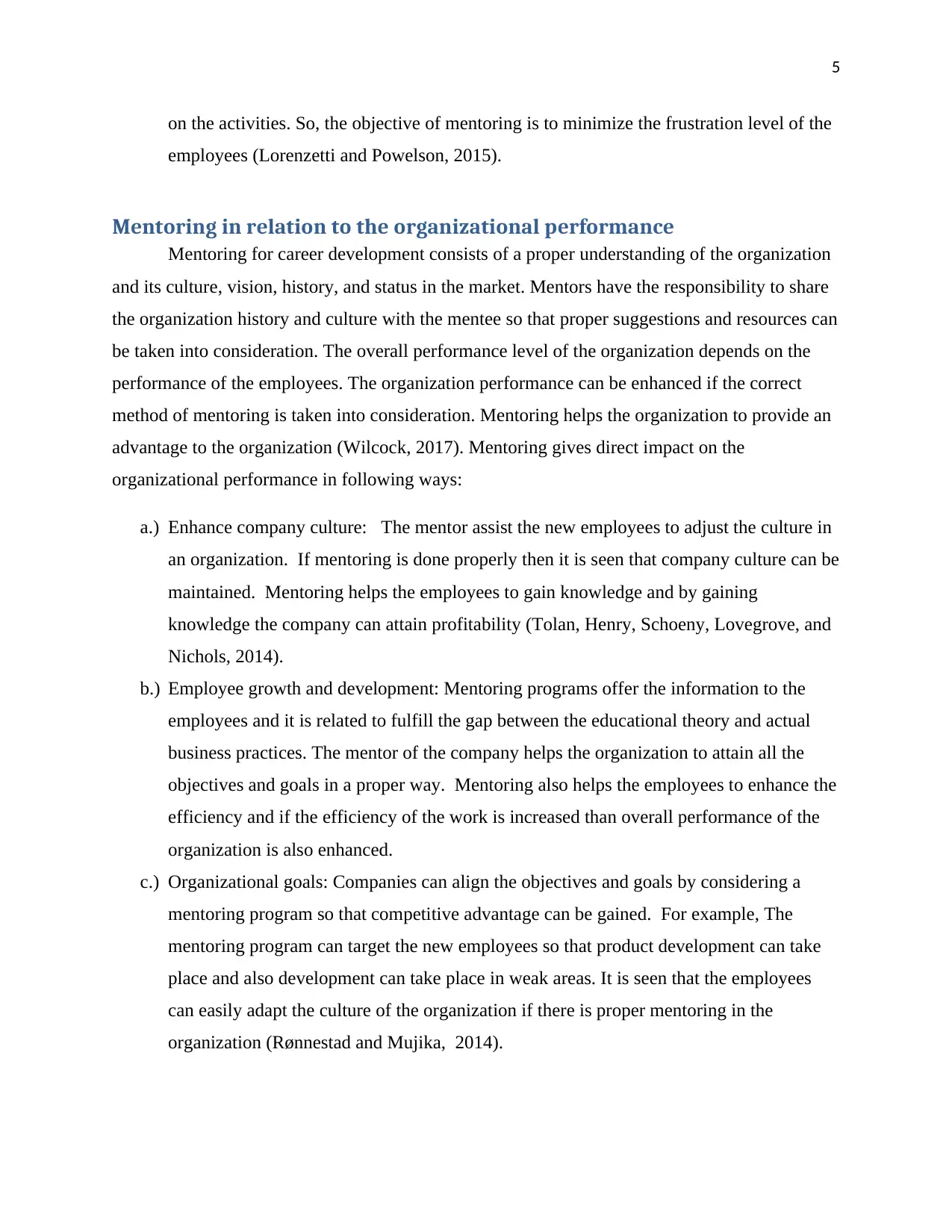
5
on the activities. So, the objective of mentoring is to minimize the frustration level of the
employees (Lorenzetti and Powelson, 2015).
Mentoring in relation to the organizational performance
Mentoring for career development consists of a proper understanding of the organization
and its culture, vision, history, and status in the market. Mentors have the responsibility to share
the organization history and culture with the mentee so that proper suggestions and resources can
be taken into consideration. The overall performance level of the organization depends on the
performance of the employees. The organization performance can be enhanced if the correct
method of mentoring is taken into consideration. Mentoring helps the organization to provide an
advantage to the organization (Wilcock, 2017). Mentoring gives direct impact on the
organizational performance in following ways:
a.) Enhance company culture: The mentor assist the new employees to adjust the culture in
an organization. If mentoring is done properly then it is seen that company culture can be
maintained. Mentoring helps the employees to gain knowledge and by gaining
knowledge the company can attain profitability (Tolan, Henry, Schoeny, Lovegrove, and
Nichols, 2014).
b.) Employee growth and development: Mentoring programs offer the information to the
employees and it is related to fulfill the gap between the educational theory and actual
business practices. The mentor of the company helps the organization to attain all the
objectives and goals in a proper way. Mentoring also helps the employees to enhance the
efficiency and if the efficiency of the work is increased than overall performance of the
organization is also enhanced.
c.) Organizational goals: Companies can align the objectives and goals by considering a
mentoring program so that competitive advantage can be gained. For example, The
mentoring program can target the new employees so that product development can take
place and also development can take place in weak areas. It is seen that the employees
can easily adapt the culture of the organization if there is proper mentoring in the
organization (Rønnestad and Mujika, 2014).
on the activities. So, the objective of mentoring is to minimize the frustration level of the
employees (Lorenzetti and Powelson, 2015).
Mentoring in relation to the organizational performance
Mentoring for career development consists of a proper understanding of the organization
and its culture, vision, history, and status in the market. Mentors have the responsibility to share
the organization history and culture with the mentee so that proper suggestions and resources can
be taken into consideration. The overall performance level of the organization depends on the
performance of the employees. The organization performance can be enhanced if the correct
method of mentoring is taken into consideration. Mentoring helps the organization to provide an
advantage to the organization (Wilcock, 2017). Mentoring gives direct impact on the
organizational performance in following ways:
a.) Enhance company culture: The mentor assist the new employees to adjust the culture in
an organization. If mentoring is done properly then it is seen that company culture can be
maintained. Mentoring helps the employees to gain knowledge and by gaining
knowledge the company can attain profitability (Tolan, Henry, Schoeny, Lovegrove, and
Nichols, 2014).
b.) Employee growth and development: Mentoring programs offer the information to the
employees and it is related to fulfill the gap between the educational theory and actual
business practices. The mentor of the company helps the organization to attain all the
objectives and goals in a proper way. Mentoring also helps the employees to enhance the
efficiency and if the efficiency of the work is increased than overall performance of the
organization is also enhanced.
c.) Organizational goals: Companies can align the objectives and goals by considering a
mentoring program so that competitive advantage can be gained. For example, The
mentoring program can target the new employees so that product development can take
place and also development can take place in weak areas. It is seen that the employees
can easily adapt the culture of the organization if there is proper mentoring in the
organization (Rønnestad and Mujika, 2014).
⊘ This is a preview!⊘
Do you want full access?
Subscribe today to unlock all pages.

Trusted by 1+ million students worldwide
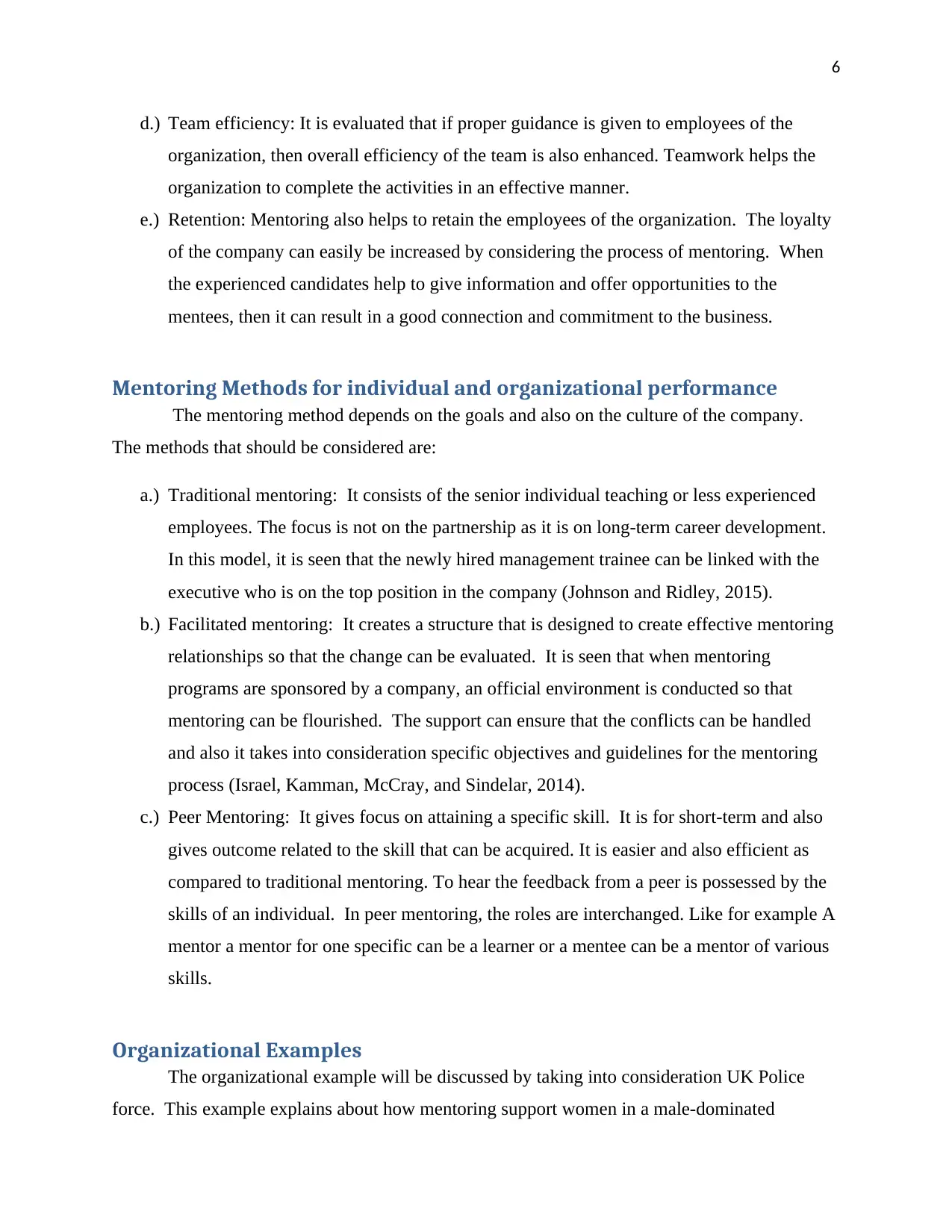
6
d.) Team efficiency: It is evaluated that if proper guidance is given to employees of the
organization, then overall efficiency of the team is also enhanced. Teamwork helps the
organization to complete the activities in an effective manner.
e.) Retention: Mentoring also helps to retain the employees of the organization. The loyalty
of the company can easily be increased by considering the process of mentoring. When
the experienced candidates help to give information and offer opportunities to the
mentees, then it can result in a good connection and commitment to the business.
Mentoring Methods for individual and organizational performance
The mentoring method depends on the goals and also on the culture of the company.
The methods that should be considered are:
a.) Traditional mentoring: It consists of the senior individual teaching or less experienced
employees. The focus is not on the partnership as it is on long-term career development.
In this model, it is seen that the newly hired management trainee can be linked with the
executive who is on the top position in the company (Johnson and Ridley, 2015).
b.) Facilitated mentoring: It creates a structure that is designed to create effective mentoring
relationships so that the change can be evaluated. It is seen that when mentoring
programs are sponsored by a company, an official environment is conducted so that
mentoring can be flourished. The support can ensure that the conflicts can be handled
and also it takes into consideration specific objectives and guidelines for the mentoring
process (Israel, Kamman, McCray, and Sindelar, 2014).
c.) Peer Mentoring: It gives focus on attaining a specific skill. It is for short-term and also
gives outcome related to the skill that can be acquired. It is easier and also efficient as
compared to traditional mentoring. To hear the feedback from a peer is possessed by the
skills of an individual. In peer mentoring, the roles are interchanged. Like for example A
mentor a mentor for one specific can be a learner or a mentee can be a mentor of various
skills.
Organizational Examples
The organizational example will be discussed by taking into consideration UK Police
force. This example explains about how mentoring support women in a male-dominated
d.) Team efficiency: It is evaluated that if proper guidance is given to employees of the
organization, then overall efficiency of the team is also enhanced. Teamwork helps the
organization to complete the activities in an effective manner.
e.) Retention: Mentoring also helps to retain the employees of the organization. The loyalty
of the company can easily be increased by considering the process of mentoring. When
the experienced candidates help to give information and offer opportunities to the
mentees, then it can result in a good connection and commitment to the business.
Mentoring Methods for individual and organizational performance
The mentoring method depends on the goals and also on the culture of the company.
The methods that should be considered are:
a.) Traditional mentoring: It consists of the senior individual teaching or less experienced
employees. The focus is not on the partnership as it is on long-term career development.
In this model, it is seen that the newly hired management trainee can be linked with the
executive who is on the top position in the company (Johnson and Ridley, 2015).
b.) Facilitated mentoring: It creates a structure that is designed to create effective mentoring
relationships so that the change can be evaluated. It is seen that when mentoring
programs are sponsored by a company, an official environment is conducted so that
mentoring can be flourished. The support can ensure that the conflicts can be handled
and also it takes into consideration specific objectives and guidelines for the mentoring
process (Israel, Kamman, McCray, and Sindelar, 2014).
c.) Peer Mentoring: It gives focus on attaining a specific skill. It is for short-term and also
gives outcome related to the skill that can be acquired. It is easier and also efficient as
compared to traditional mentoring. To hear the feedback from a peer is possessed by the
skills of an individual. In peer mentoring, the roles are interchanged. Like for example A
mentor a mentor for one specific can be a learner or a mentee can be a mentor of various
skills.
Organizational Examples
The organizational example will be discussed by taking into consideration UK Police
force. This example explains about how mentoring support women in a male-dominated
Paraphrase This Document
Need a fresh take? Get an instant paraphrase of this document with our AI Paraphraser
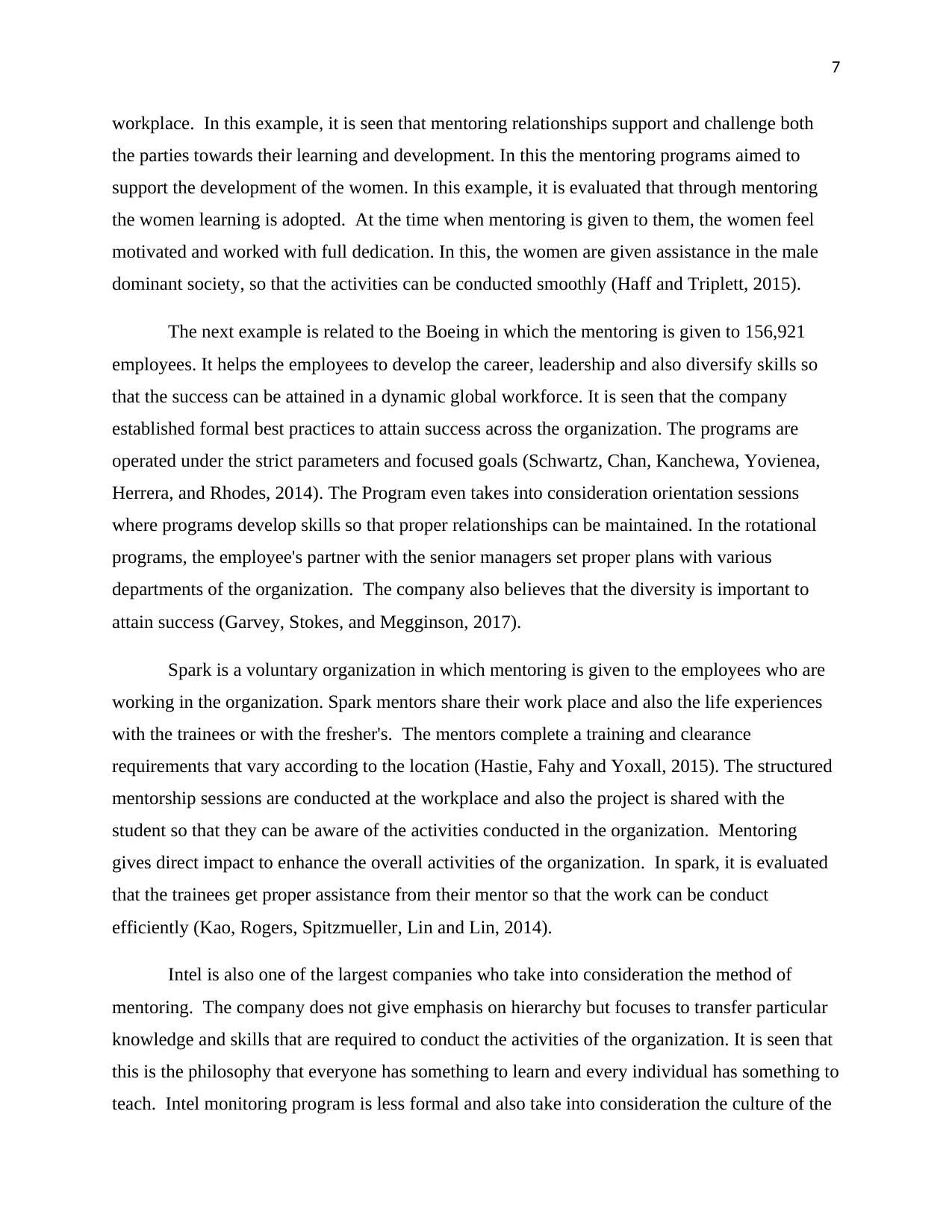
7
workplace. In this example, it is seen that mentoring relationships support and challenge both
the parties towards their learning and development. In this the mentoring programs aimed to
support the development of the women. In this example, it is evaluated that through mentoring
the women learning is adopted. At the time when mentoring is given to them, the women feel
motivated and worked with full dedication. In this, the women are given assistance in the male
dominant society, so that the activities can be conducted smoothly (Haff and Triplett, 2015).
The next example is related to the Boeing in which the mentoring is given to 156,921
employees. It helps the employees to develop the career, leadership and also diversify skills so
that the success can be attained in a dynamic global workforce. It is seen that the company
established formal best practices to attain success across the organization. The programs are
operated under the strict parameters and focused goals (Schwartz, Chan, Kanchewa, Yovienea,
Herrera, and Rhodes, 2014). The Program even takes into consideration orientation sessions
where programs develop skills so that proper relationships can be maintained. In the rotational
programs, the employee's partner with the senior managers set proper plans with various
departments of the organization. The company also believes that the diversity is important to
attain success (Garvey, Stokes, and Megginson, 2017).
Spark is a voluntary organization in which mentoring is given to the employees who are
working in the organization. Spark mentors share their work place and also the life experiences
with the trainees or with the fresher's. The mentors complete a training and clearance
requirements that vary according to the location (Hastie, Fahy and Yoxall, 2015). The structured
mentorship sessions are conducted at the workplace and also the project is shared with the
student so that they can be aware of the activities conducted in the organization. Mentoring
gives direct impact to enhance the overall activities of the organization. In spark, it is evaluated
that the trainees get proper assistance from their mentor so that the work can be conduct
efficiently (Kao, Rogers, Spitzmueller, Lin and Lin, 2014).
Intel is also one of the largest companies who take into consideration the method of
mentoring. The company does not give emphasis on hierarchy but focuses to transfer particular
knowledge and skills that are required to conduct the activities of the organization. It is seen that
this is the philosophy that everyone has something to learn and every individual has something to
teach. Intel monitoring program is less formal and also take into consideration the culture of the
workplace. In this example, it is seen that mentoring relationships support and challenge both
the parties towards their learning and development. In this the mentoring programs aimed to
support the development of the women. In this example, it is evaluated that through mentoring
the women learning is adopted. At the time when mentoring is given to them, the women feel
motivated and worked with full dedication. In this, the women are given assistance in the male
dominant society, so that the activities can be conducted smoothly (Haff and Triplett, 2015).
The next example is related to the Boeing in which the mentoring is given to 156,921
employees. It helps the employees to develop the career, leadership and also diversify skills so
that the success can be attained in a dynamic global workforce. It is seen that the company
established formal best practices to attain success across the organization. The programs are
operated under the strict parameters and focused goals (Schwartz, Chan, Kanchewa, Yovienea,
Herrera, and Rhodes, 2014). The Program even takes into consideration orientation sessions
where programs develop skills so that proper relationships can be maintained. In the rotational
programs, the employee's partner with the senior managers set proper plans with various
departments of the organization. The company also believes that the diversity is important to
attain success (Garvey, Stokes, and Megginson, 2017).
Spark is a voluntary organization in which mentoring is given to the employees who are
working in the organization. Spark mentors share their work place and also the life experiences
with the trainees or with the fresher's. The mentors complete a training and clearance
requirements that vary according to the location (Hastie, Fahy and Yoxall, 2015). The structured
mentorship sessions are conducted at the workplace and also the project is shared with the
student so that they can be aware of the activities conducted in the organization. Mentoring
gives direct impact to enhance the overall activities of the organization. In spark, it is evaluated
that the trainees get proper assistance from their mentor so that the work can be conduct
efficiently (Kao, Rogers, Spitzmueller, Lin and Lin, 2014).
Intel is also one of the largest companies who take into consideration the method of
mentoring. The company does not give emphasis on hierarchy but focuses to transfer particular
knowledge and skills that are required to conduct the activities of the organization. It is seen that
this is the philosophy that everyone has something to learn and every individual has something to
teach. Intel monitoring program is less formal and also take into consideration the culture of the
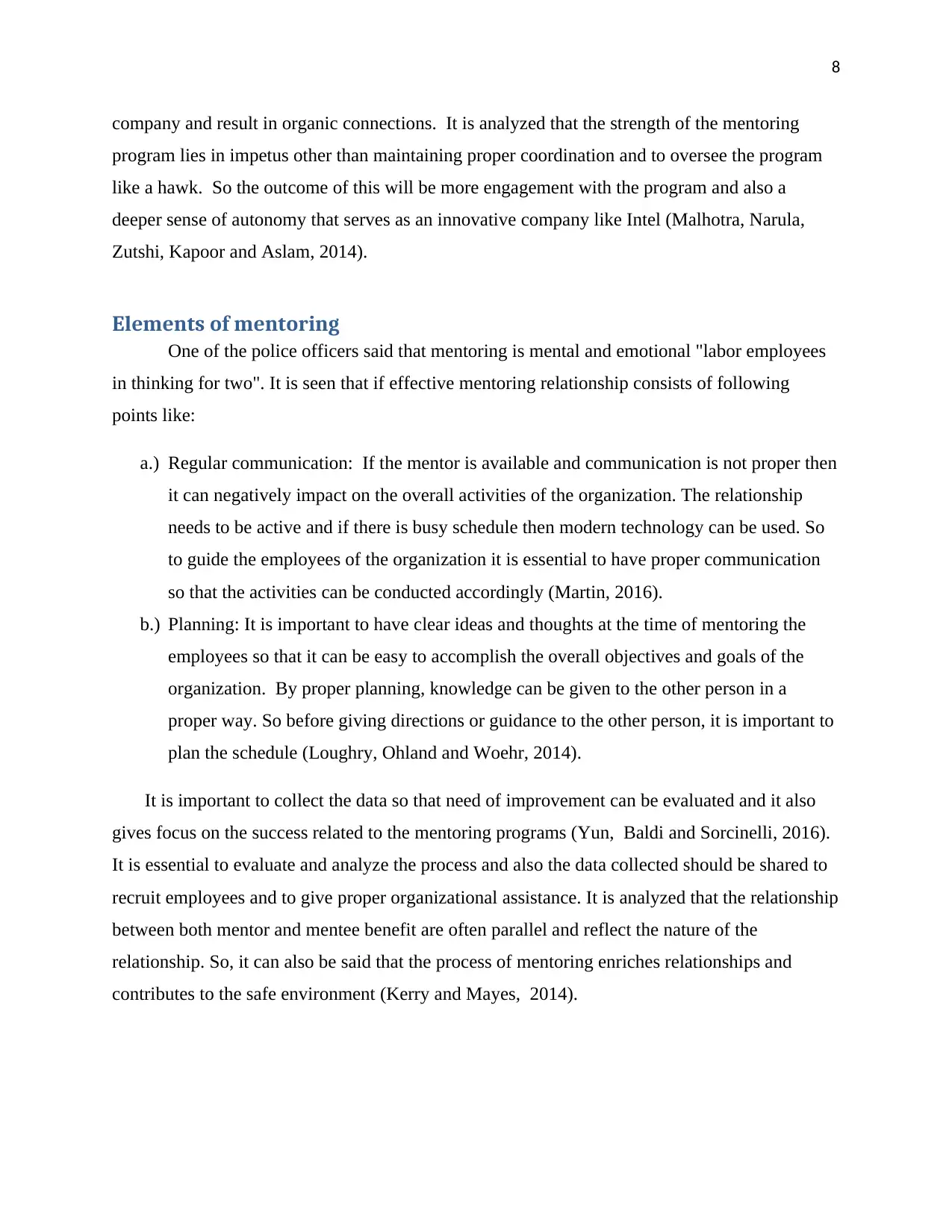
8
company and result in organic connections. It is analyzed that the strength of the mentoring
program lies in impetus other than maintaining proper coordination and to oversee the program
like a hawk. So the outcome of this will be more engagement with the program and also a
deeper sense of autonomy that serves as an innovative company like Intel (Malhotra, Narula,
Zutshi, Kapoor and Aslam, 2014).
Elements of mentoring
One of the police officers said that mentoring is mental and emotional "labor employees
in thinking for two". It is seen that if effective mentoring relationship consists of following
points like:
a.) Regular communication: If the mentor is available and communication is not proper then
it can negatively impact on the overall activities of the organization. The relationship
needs to be active and if there is busy schedule then modern technology can be used. So
to guide the employees of the organization it is essential to have proper communication
so that the activities can be conducted accordingly (Martin, 2016).
b.) Planning: It is important to have clear ideas and thoughts at the time of mentoring the
employees so that it can be easy to accomplish the overall objectives and goals of the
organization. By proper planning, knowledge can be given to the other person in a
proper way. So before giving directions or guidance to the other person, it is important to
plan the schedule (Loughry, Ohland and Woehr, 2014).
It is important to collect the data so that need of improvement can be evaluated and it also
gives focus on the success related to the mentoring programs (Yun, Baldi and Sorcinelli, 2016).
It is essential to evaluate and analyze the process and also the data collected should be shared to
recruit employees and to give proper organizational assistance. It is analyzed that the relationship
between both mentor and mentee benefit are often parallel and reflect the nature of the
relationship. So, it can also be said that the process of mentoring enriches relationships and
contributes to the safe environment (Kerry and Mayes, 2014).
company and result in organic connections. It is analyzed that the strength of the mentoring
program lies in impetus other than maintaining proper coordination and to oversee the program
like a hawk. So the outcome of this will be more engagement with the program and also a
deeper sense of autonomy that serves as an innovative company like Intel (Malhotra, Narula,
Zutshi, Kapoor and Aslam, 2014).
Elements of mentoring
One of the police officers said that mentoring is mental and emotional "labor employees
in thinking for two". It is seen that if effective mentoring relationship consists of following
points like:
a.) Regular communication: If the mentor is available and communication is not proper then
it can negatively impact on the overall activities of the organization. The relationship
needs to be active and if there is busy schedule then modern technology can be used. So
to guide the employees of the organization it is essential to have proper communication
so that the activities can be conducted accordingly (Martin, 2016).
b.) Planning: It is important to have clear ideas and thoughts at the time of mentoring the
employees so that it can be easy to accomplish the overall objectives and goals of the
organization. By proper planning, knowledge can be given to the other person in a
proper way. So before giving directions or guidance to the other person, it is important to
plan the schedule (Loughry, Ohland and Woehr, 2014).
It is important to collect the data so that need of improvement can be evaluated and it also
gives focus on the success related to the mentoring programs (Yun, Baldi and Sorcinelli, 2016).
It is essential to evaluate and analyze the process and also the data collected should be shared to
recruit employees and to give proper organizational assistance. It is analyzed that the relationship
between both mentor and mentee benefit are often parallel and reflect the nature of the
relationship. So, it can also be said that the process of mentoring enriches relationships and
contributes to the safe environment (Kerry and Mayes, 2014).
⊘ This is a preview!⊘
Do you want full access?
Subscribe today to unlock all pages.

Trusted by 1+ million students worldwide
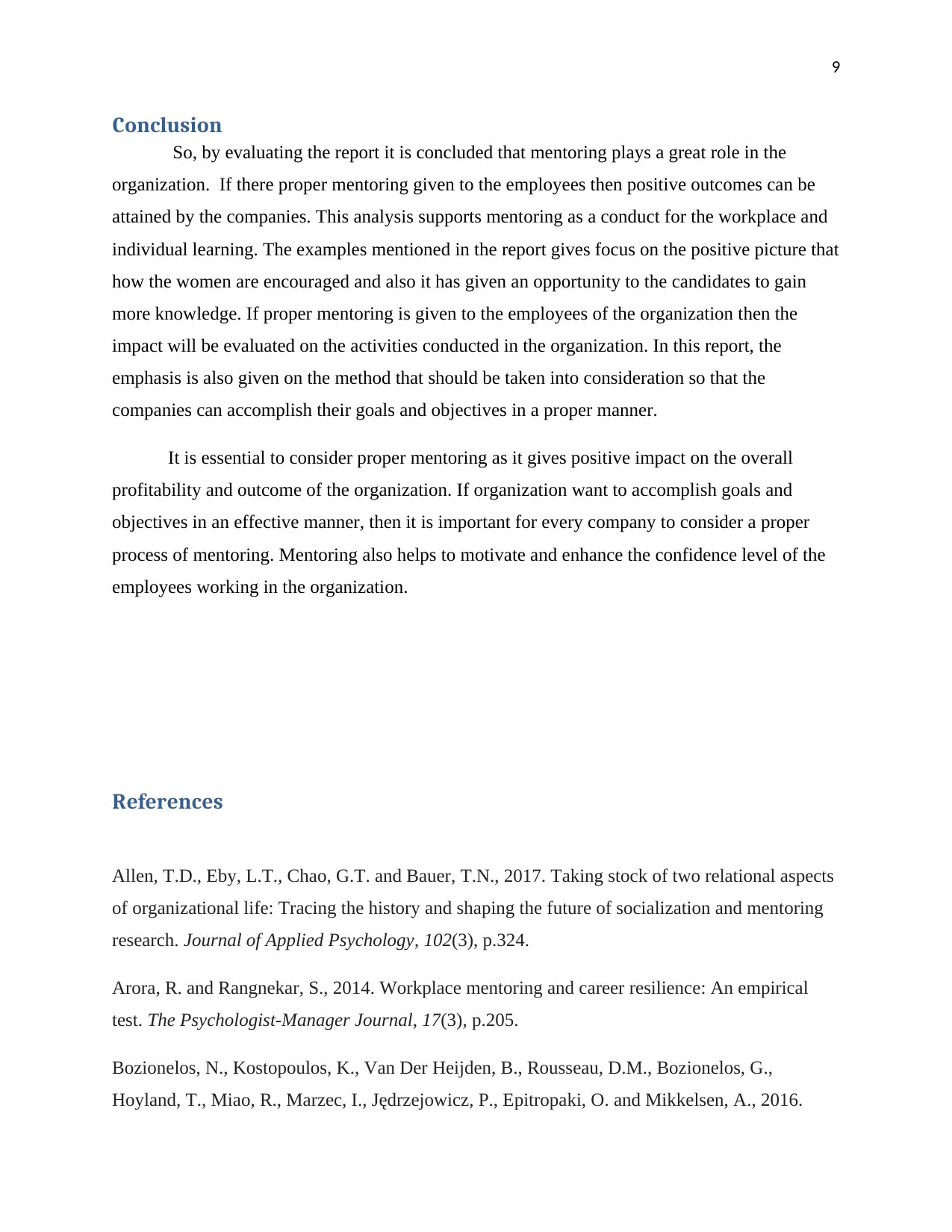
9
Conclusion
So, by evaluating the report it is concluded that mentoring plays a great role in the
organization. If there proper mentoring given to the employees then positive outcomes can be
attained by the companies. This analysis supports mentoring as a conduct for the workplace and
individual learning. The examples mentioned in the report gives focus on the positive picture that
how the women are encouraged and also it has given an opportunity to the candidates to gain
more knowledge. If proper mentoring is given to the employees of the organization then the
impact will be evaluated on the activities conducted in the organization. In this report, the
emphasis is also given on the method that should be taken into consideration so that the
companies can accomplish their goals and objectives in a proper manner.
It is essential to consider proper mentoring as it gives positive impact on the overall
profitability and outcome of the organization. If organization want to accomplish goals and
objectives in an effective manner, then it is important for every company to consider a proper
process of mentoring. Mentoring also helps to motivate and enhance the confidence level of the
employees working in the organization.
References
Allen, T.D., Eby, L.T., Chao, G.T. and Bauer, T.N., 2017. Taking stock of two relational aspects
of organizational life: Tracing the history and shaping the future of socialization and mentoring
research. Journal of Applied Psychology, 102(3), p.324.
Arora, R. and Rangnekar, S., 2014. Workplace mentoring and career resilience: An empirical
test. The Psychologist-Manager Journal, 17(3), p.205.
Bozionelos, N., Kostopoulos, K., Van Der Heijden, B., Rousseau, D.M., Bozionelos, G.,
Hoyland, T., Miao, R., Marzec, I., Jędrzejowicz, P., Epitropaki, O. and Mikkelsen, A., 2016.
Conclusion
So, by evaluating the report it is concluded that mentoring plays a great role in the
organization. If there proper mentoring given to the employees then positive outcomes can be
attained by the companies. This analysis supports mentoring as a conduct for the workplace and
individual learning. The examples mentioned in the report gives focus on the positive picture that
how the women are encouraged and also it has given an opportunity to the candidates to gain
more knowledge. If proper mentoring is given to the employees of the organization then the
impact will be evaluated on the activities conducted in the organization. In this report, the
emphasis is also given on the method that should be taken into consideration so that the
companies can accomplish their goals and objectives in a proper manner.
It is essential to consider proper mentoring as it gives positive impact on the overall
profitability and outcome of the organization. If organization want to accomplish goals and
objectives in an effective manner, then it is important for every company to consider a proper
process of mentoring. Mentoring also helps to motivate and enhance the confidence level of the
employees working in the organization.
References
Allen, T.D., Eby, L.T., Chao, G.T. and Bauer, T.N., 2017. Taking stock of two relational aspects
of organizational life: Tracing the history and shaping the future of socialization and mentoring
research. Journal of Applied Psychology, 102(3), p.324.
Arora, R. and Rangnekar, S., 2014. Workplace mentoring and career resilience: An empirical
test. The Psychologist-Manager Journal, 17(3), p.205.
Bozionelos, N., Kostopoulos, K., Van Der Heijden, B., Rousseau, D.M., Bozionelos, G.,
Hoyland, T., Miao, R., Marzec, I., Jędrzejowicz, P., Epitropaki, O. and Mikkelsen, A., 2016.
Paraphrase This Document
Need a fresh take? Get an instant paraphrase of this document with our AI Paraphraser
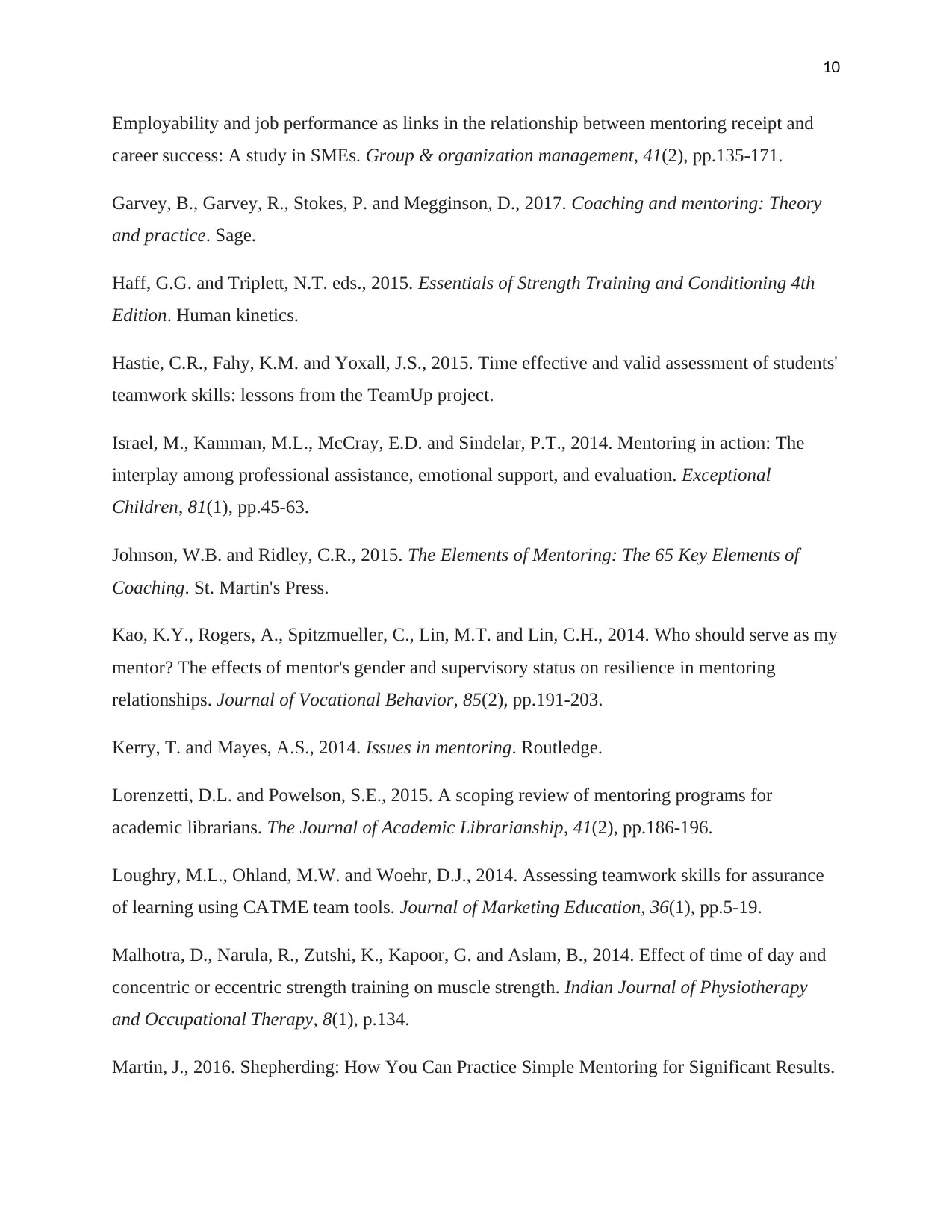
10
Employability and job performance as links in the relationship between mentoring receipt and
career success: A study in SMEs. Group & organization management, 41(2), pp.135-171.
Garvey, B., Garvey, R., Stokes, P. and Megginson, D., 2017. Coaching and mentoring: Theory
and practice. Sage.
Haff, G.G. and Triplett, N.T. eds., 2015. Essentials of Strength Training and Conditioning 4th
Edition. Human kinetics.
Hastie, C.R., Fahy, K.M. and Yoxall, J.S., 2015. Time effective and valid assessment of students'
teamwork skills: lessons from the TeamUp project.
Israel, M., Kamman, M.L., McCray, E.D. and Sindelar, P.T., 2014. Mentoring in action: The
interplay among professional assistance, emotional support, and evaluation. Exceptional
Children, 81(1), pp.45-63.
Johnson, W.B. and Ridley, C.R., 2015. The Elements of Mentoring: The 65 Key Elements of
Coaching. St. Martin's Press.
Kao, K.Y., Rogers, A., Spitzmueller, C., Lin, M.T. and Lin, C.H., 2014. Who should serve as my
mentor? The effects of mentor's gender and supervisory status on resilience in mentoring
relationships. Journal of Vocational Behavior, 85(2), pp.191-203.
Kerry, T. and Mayes, A.S., 2014. Issues in mentoring. Routledge.
Lorenzetti, D.L. and Powelson, S.E., 2015. A scoping review of mentoring programs for
academic librarians. The Journal of Academic Librarianship, 41(2), pp.186-196.
Loughry, M.L., Ohland, M.W. and Woehr, D.J., 2014. Assessing teamwork skills for assurance
of learning using CATME team tools. Journal of Marketing Education, 36(1), pp.5-19.
Malhotra, D., Narula, R., Zutshi, K., Kapoor, G. and Aslam, B., 2014. Effect of time of day and
concentric or eccentric strength training on muscle strength. Indian Journal of Physiotherapy
and Occupational Therapy, 8(1), p.134.
Martin, J., 2016. Shepherding: How You Can Practice Simple Mentoring for Significant Results.
Employability and job performance as links in the relationship between mentoring receipt and
career success: A study in SMEs. Group & organization management, 41(2), pp.135-171.
Garvey, B., Garvey, R., Stokes, P. and Megginson, D., 2017. Coaching and mentoring: Theory
and practice. Sage.
Haff, G.G. and Triplett, N.T. eds., 2015. Essentials of Strength Training and Conditioning 4th
Edition. Human kinetics.
Hastie, C.R., Fahy, K.M. and Yoxall, J.S., 2015. Time effective and valid assessment of students'
teamwork skills: lessons from the TeamUp project.
Israel, M., Kamman, M.L., McCray, E.D. and Sindelar, P.T., 2014. Mentoring in action: The
interplay among professional assistance, emotional support, and evaluation. Exceptional
Children, 81(1), pp.45-63.
Johnson, W.B. and Ridley, C.R., 2015. The Elements of Mentoring: The 65 Key Elements of
Coaching. St. Martin's Press.
Kao, K.Y., Rogers, A., Spitzmueller, C., Lin, M.T. and Lin, C.H., 2014. Who should serve as my
mentor? The effects of mentor's gender and supervisory status on resilience in mentoring
relationships. Journal of Vocational Behavior, 85(2), pp.191-203.
Kerry, T. and Mayes, A.S., 2014. Issues in mentoring. Routledge.
Lorenzetti, D.L. and Powelson, S.E., 2015. A scoping review of mentoring programs for
academic librarians. The Journal of Academic Librarianship, 41(2), pp.186-196.
Loughry, M.L., Ohland, M.W. and Woehr, D.J., 2014. Assessing teamwork skills for assurance
of learning using CATME team tools. Journal of Marketing Education, 36(1), pp.5-19.
Malhotra, D., Narula, R., Zutshi, K., Kapoor, G. and Aslam, B., 2014. Effect of time of day and
concentric or eccentric strength training on muscle strength. Indian Journal of Physiotherapy
and Occupational Therapy, 8(1), p.134.
Martin, J., 2016. Shepherding: How You Can Practice Simple Mentoring for Significant Results.
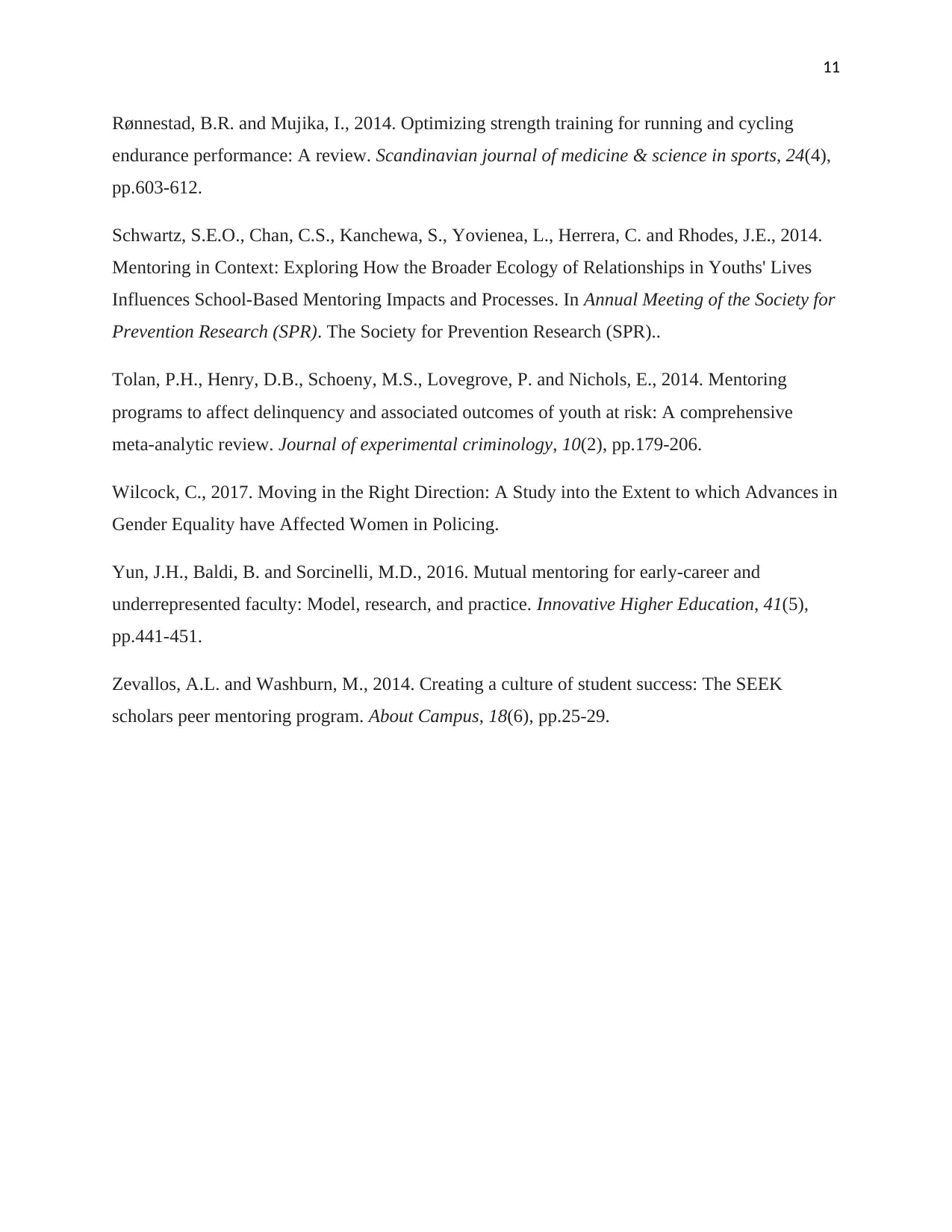
11
Rønnestad, B.R. and Mujika, I., 2014. Optimizing strength training for running and cycling
endurance performance: A review. Scandinavian journal of medicine & science in sports, 24(4),
pp.603-612.
Schwartz, S.E.O., Chan, C.S., Kanchewa, S., Yovienea, L., Herrera, C. and Rhodes, J.E., 2014.
Mentoring in Context: Exploring How the Broader Ecology of Relationships in Youths' Lives
Influences School-Based Mentoring Impacts and Processes. In Annual Meeting of the Society for
Prevention Research (SPR). The Society for Prevention Research (SPR)..
Tolan, P.H., Henry, D.B., Schoeny, M.S., Lovegrove, P. and Nichols, E., 2014. Mentoring
programs to affect delinquency and associated outcomes of youth at risk: A comprehensive
meta-analytic review. Journal of experimental criminology, 10(2), pp.179-206.
Wilcock, C., 2017. Moving in the Right Direction: A Study into the Extent to which Advances in
Gender Equality have Affected Women in Policing.
Yun, J.H., Baldi, B. and Sorcinelli, M.D., 2016. Mutual mentoring for early-career and
underrepresented faculty: Model, research, and practice. Innovative Higher Education, 41(5),
pp.441-451.
Zevallos, A.L. and Washburn, M., 2014. Creating a culture of student success: The SEEK
scholars peer mentoring program. About Campus, 18(6), pp.25-29.
Rønnestad, B.R. and Mujika, I., 2014. Optimizing strength training for running and cycling
endurance performance: A review. Scandinavian journal of medicine & science in sports, 24(4),
pp.603-612.
Schwartz, S.E.O., Chan, C.S., Kanchewa, S., Yovienea, L., Herrera, C. and Rhodes, J.E., 2014.
Mentoring in Context: Exploring How the Broader Ecology of Relationships in Youths' Lives
Influences School-Based Mentoring Impacts and Processes. In Annual Meeting of the Society for
Prevention Research (SPR). The Society for Prevention Research (SPR)..
Tolan, P.H., Henry, D.B., Schoeny, M.S., Lovegrove, P. and Nichols, E., 2014. Mentoring
programs to affect delinquency and associated outcomes of youth at risk: A comprehensive
meta-analytic review. Journal of experimental criminology, 10(2), pp.179-206.
Wilcock, C., 2017. Moving in the Right Direction: A Study into the Extent to which Advances in
Gender Equality have Affected Women in Policing.
Yun, J.H., Baldi, B. and Sorcinelli, M.D., 2016. Mutual mentoring for early-career and
underrepresented faculty: Model, research, and practice. Innovative Higher Education, 41(5),
pp.441-451.
Zevallos, A.L. and Washburn, M., 2014. Creating a culture of student success: The SEEK
scholars peer mentoring program. About Campus, 18(6), pp.25-29.
⊘ This is a preview!⊘
Do you want full access?
Subscribe today to unlock all pages.

Trusted by 1+ million students worldwide
1 out of 12
Related Documents
Your All-in-One AI-Powered Toolkit for Academic Success.
+13062052269
info@desklib.com
Available 24*7 on WhatsApp / Email
![[object Object]](/_next/static/media/star-bottom.7253800d.svg)
Unlock your academic potential
Copyright © 2020–2025 A2Z Services. All Rights Reserved. Developed and managed by ZUCOL.




